
All the Victorians did it. They knew what to do to keep clothes lasting longer. They finagled fabric and thread until it gave them the silhouette they wanted.
One of the best things they utilized was the method of using a second or third layer of fabric to stiffen a particular area of a garment. (You may have heard of this as flatlining or mounting.) This reinforcement gave body to the fashion fabric, supported the silhouette desired, and miraculously cut down on the wear & tear of the garment.
Most obvious of this reinforcement layer is this use of supportive fabric in skirt hems known as hem facings.
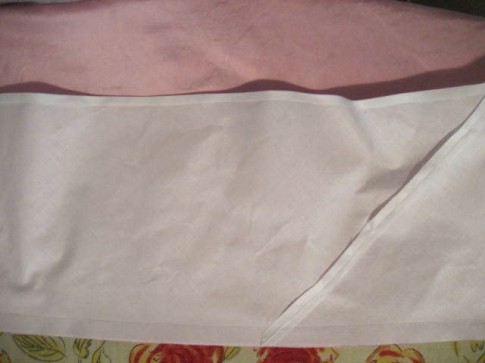
Rarely did the mid-to-late 19th C. woman hem her skirt with just turning it up once and stitching down. No, they were as attentive to the bottom of their garments as anything else. Really if you think about it, the skirt hem gets nearly the same amount of wear (if not more) as the wrist cuff. Those folded up edges take a beating.
Generally, in modern sewing terms, facings finish raw edges and help support them as well. The facing is sewn on to the garment then turned to the inside and either left loose or tacked down. Cut on the same grain as the garment or a true bias, facings follow the edges to be finished like armholes in sleeveless tops and necklines.
In historical sewing, facings are kind of a mix of flatlining (a full lining layer) and simple edge finishes like bias strips. They can be flatlined to the inside of a garment which the raw edges are then finished together. Or facings can be shortened linings actually finishing a raw edge like in modern garments.
In terms of skirt hem facings specifically, there are two methods I’ve found to be the best when finishing the hems in skirts.
- Wide sections of fabric are laid flat on the inside of the skirt with the lower raw edges matching. The raw edges are then finished together.
- The facing and skirt are placed right sides together, seamed and the facing turned to the inside of the skirt.
Both these methods serve the purpose of supporting the skirt hem and are used according to the type of skirt and time period you are working with.
Types & Widths Of Hem Facings
Hem facings are a traditional way to finish the lower edges of skirts. They can be cut in straight strips across the fabric or on the bias for use in shaped or curved hems.
If your skirt is cut in straight panels such as those in the 1830s to 1850s, straight strips of fabric are fine to use as a hem facing. Straight hem facings can be from 1” up to 12” or more. In 1830s skirts, the hem facing could go as high as knee level.
For curved hems, as most skirts are, strips cut on the bias are best and can be anywhere from 1” to 6” or more in width.
Fabrics To Use
Hem facings can be cut from the fashion fabric or from a lining or underlining fabric. Being a support to the skirt fashion fabric, the facing fabric will depend on the time period you are creating. The style of the skirt and the weight needed at the hemline are also considered in choosing your facing fabric.
Try a heavy, tightly-woven cotton muslin for lighter-weight dress fabrics. Polished cotton (chintz) was VERY popular for underlinings and facings in the 19th Century and can be used from light cottons to heavy wools and silks.
Silk organza, although a fabulous bodice and collar underlining is not recommended for skirt facings because of the wear a skirt gets. Use a light muslin or calico instead.
Cotton organdy, the costumer’s dream fabric, is perfect hem facing material. Make sure to use the appropriate stiffness according to your fashion fabric. The stiffest stuff is great for 1890s hems which really need that hem support as it kicks out over the petticoats.
To strengthen a curved hem, modern horsehair braid can be enclosed between the bias hem facing and skirt. It is especially effective in kicking out the hem from the petticoats.
The modern horsehair braid available is a nylon mesh woven on a bias grain. It is usually sold in clear or black and comes in ½” to 3” widths. Wider goods are sold but it can get real expensive real fast.
As an option to horsehair, you can use hair canvas (found in the interfacing section of a fabric store) or a heavy fabric cut into bias strips and used as an inner layer between your hem facing and skirt. This would add weight and form to the skirt. Hair canvas is best for wool skirts.
Reproduction Costume Samples
Here are some examples of hem facings in use in reproduction costumes.
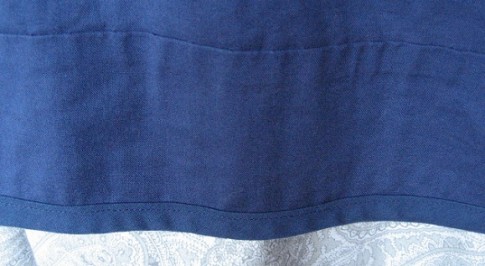
Above is a 1860s straight panel skirt with a straight hem facing of 3”. To further protect the lower edge of the skirt, a plain cotton bias tape was wrapped over the folded hem and top stitched on. This bias tape can be easily replaced and keeps the skirt in good condition.
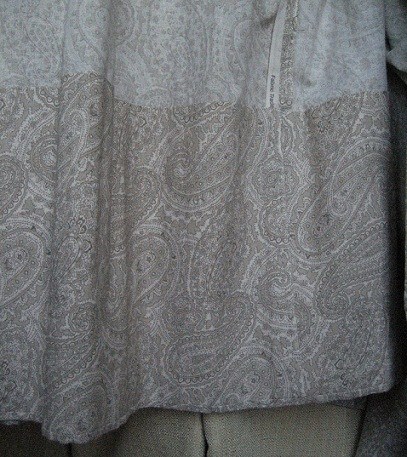
Above is a 12” wide straight hem facing applied to a straight panel 1830s skirt. The facing is in the fashion fabric. After the facing was stitched to the skirt right sides together, the seam was rolled ¼” to the inside so the seam was not seen from the correct side. This is a period method that leaves the bottom of the skirt as a fold rather than a seam.
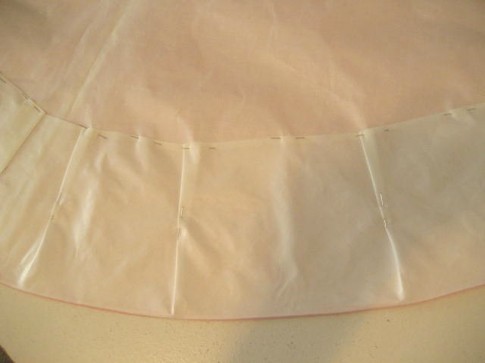
Above is a sharply curved 1870s skirt train with a 6” bias hem facing. The skirt was flatlined in a polished cotton and the facing cut from the same material.
You can see the small darts taken up in the hem facing to match the curve of the train or skirt hem. These darts are historically correct as seen on some original garments. Most often this hem facing was covered with a balayeuse or street sweeper which is simply a pleated ruffle that kept the hem edge clean and could be easily removed and cleaned or replaced.
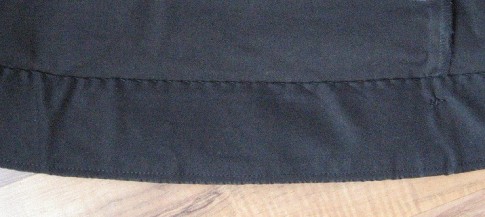
This is another bias hem facing applied to a 1870s natural form era curved skirt hem. A 2” wide strip of horsehair was sandwiched between the skirt and the hem facing before the facing was whipstitched to the skirt.
Do you finish your skirts with hem facings? Have you noticed the difference they make in the overall silhouette of your skirt? After a costume was completed, do you wish a longer or shorter hem facing was used?

Hi Jennifer,
I’m tackling an Early Bustle project for the end of the month, and will flatline my skirt- would a facing also help? As it’s white, it will also have a street sweeper. Is horsehair braid between the layers going too far? Your posts are fabulous and help this beginner so much! Thanks for sharing and answering so many questions.
Horsehair would depend on your fashion fabric. Remember, underlinings and facings are to support the fashion fabric. My post on flatlining skirts may help you further.
Would 6″ horsehair be overkill for a hem facing? I’ve got a bunch of it leftover from another project… I wouldn’t be surprisedit it was overdoing it but no harm in asking, right? 🙂
Depends on the era, but no, not overkill. But again, really depends on how the skirt should hang for your chosen time period.
Ah yes, of course. In this case, it’s a very basic underskirt going over a modest bustle…
I pretty much always recommend a hem facing, if only a couple inches. The deep size will give weight to the skirt and help hold it in place over the undergarments. You could place the horsehair inside two layers of your fabric to see how firm it makes the fabric and if it’s worth it to use it or save for another skirt.
Hi Jennifer,
I don’t know if this is a historically correct method; however, it worked well the time I used it. It was in TV 261. I added purchased piping where the pleats were attached. It made the skirt stick out a bit, somewhat like a corded slip would.
Would cotton crinoline be a good hem facing material? It is certainly stiffer than organdy. I’m new to 19th century (beyond Regency) and I’m not quite sure if I need to face the hem of the natural form tie back skirt I’m making. Would I just need the facing in the front? Skirt is silk taffeta and I’m thinking of flat lining it in silk organza. Thanks for your advice! I’ve learned a lot from your blog. This era is so new to me!
It would be stiffer than organdy but would work as a hem facing. Not sure it would be best for a Natural Form skirt however. I’d stick with organdy or cut a very narrow underlining facing with the crinoline, like 1.5″ or 2″ max. A hem facing IS the hem out of fashion fabric or other lining fabric, so you’d need to apply it to the entire skirt hem. The crinoline or organdy is an underlining or backing to the facing out of fabric put in for hem support. Flatlining in silk organza is fantastic! Good luck!
Hi Jennifer, thank you for your very informative site. I thought you might be interested in some hem finishes that I looked at on 1866 dresses at the Bath Costume Museum in the UK, which had a 6″ band of stiffened cotton with a small herringbone braid at the hemline which peeped beneath the skirt. Several examples showed this. Is there any way I can send you some pictures for you to see?
Regards,
Beryl
I am trying to draft an original design for a gored skirt with knife pleating in back (i.e. I don’t have a pattern and I want to make one anyway). I am making it from a lovely polished cotton (I think), and I want to make it “right”. I have read so many pages here my head is starting to swim. I have always just folded up a deep hem on my skirts, like 3″. Would this suffice as a facing? Should I underline the whole skirt with muslin? Should I use some of the extra fashion fabric to make bias strips to attach? I’m a little confused. It looks like you are saying that most facings are cut either on the straight grain or on the bias, but I don’t know if that eliminates deep hems. Thank you for sharing your knowledge.
Hi Judy,
The treatment would depend on the era of skirt you want to make and your fashion fabric. Instead of folding up the skirt 3″ you could make a separate facing that’s 3″ plus seam allowance and turn under which will give you similar support – you’d only have that extra seam and allowances at the very bottom. Original facings were generally cut from a strong, inexpensive and basic fabric. You could certainly cut facings from a fashion fabric if you want. For your gored skirt panels I’d recommend cutting your facing strips on the bias so they can curve with your hem. Straight panel skirts call for straight hem facings simply for best use of fabric.
Also the hem facing IS your hem. You generally don’t need to apply a facing then fold up the skirt and hem. Although that is a bit like flatlining the skirt but only around the hem. You do this when you really need the bottom of the skirt supported, and it can be used in addition with the panels entirely flatlined, or stand-alone.
Sorry for making your head swim! 😉 Learning is fun.
Cheers,
Jennifer
My two 1898 (Past Patterns) skirts of a beastly slippery light brocade have a Hymo front lining about 15 inches deep, cut on the bias. The Hymo was very carefully hand pick-stitched to the fashion fabric. Before the fashion fabric, Hymo and cotton underlining were stitched together at the lower edge, the skirt was hung for 48 hours. then edged with 3 inch wide black velveteen bias. The pattern called for a two inch wide strip, but I was afraid it would be too narrow to sew effectively. Next time! The handstitching to secure the bias took me as long as machine sewing the rest of the skirt, but I have zero wear damage, and the hem flares nicely.
First off, love your blog. Main question is how do you apply the facing without getting wrinkles in it as you sew? I know that might be simple question, but I always have problems with that.
Wrinkles how? It helps to lay out your skirt as flat as possible on a large surface so you have the most you can smoothed out at one time. Then pin the facing down. Also Notice in the last photo or so the white facing is pinched up in darts to fit the rounded hem. If you have wrinkles around the top edge of the facing then make little darts to help smooth & fit.
I am finding that you are my “go-to” source for historical sewing. Have you written about the detachable hem guards or ruffles. I’d like to add one to a couple of my skirts but I have not a clue how to start. Thanks and please, keep up the great work!
Thanks Pat! I’ve not done an article yet, but making up a simple ruffle and hand whipping it to the bottom of your skirt does the trick. It’s not as complicated as it seems.
Isn’t there a fabric that is almost horsehair in feel and hand that they use in upholstery, usually as a bottom dust catcher? Its drk grey or black and a non woven type of material. I recently “canabalized” an old box spring from my kids room and this material was tacked to the underside of the box. Now I have a good idea as to what to use this for. I wonder if you could also use the Tevek material that is available at gardening centers for this application too?
It’s probably an upholstery crinoline material.
What does one call (Google) the modern equivalent of the horsehair braid? In the past, I’ve skipped over it when required in patterns because the Joann’s staff looks at me like I’m nuts, and no one has been able to give me a good alternative. Thanks!
Modern horsehair is the plastic mesh stuff, on the bias so it stretches, and can be found near the belting at JoAnn’s (if they have it). It comes in all sorts of widths from about 3/8″ up to 10″ in clear and black. Another hem facing alternative is Hymo cloth, a modern version of vintage horsehair cloth. At chain fabric stores you can find this in the interfacing section. It is heather gray and not wide. Don’t be surprised at the higher price.
Wonderful information. Thank you so much for sharing your knowledge with us.
But… how do you keep such a long facing piece from flipping outward? The back of my last 1880s skirt was two very wide gores. Just attaching the upper edge of a facing to the seam allowance couldn’t control such a long strip, could it?
Actually, the entire top edge of the facing (on all my projects) is hand tacked to the skirt body, either the underlining if there is one or the skirt fabric itself. Tiny tacking stitches where only a thread or two of the skirt is picked up by the needle. Only tacking a long hem facing to the seam allowances is like having no facing at all. There is no support of the lower section of the skirt that way.
I have a problem of my heel catching in my back hem and pulling it out, so matter how well I stitch it. Would using the horsehair work for this?
Make your hand stitches closer together. I would bet your stitches are at least 1/2″ or more apart and the corner of your heel is snagging an area between. Using horsehair would help hold the hem out and away from your shoes a bit but won’t solve the issue entirely. You could also make the hem facing wider (go higher up on the inside) and that’ll help.
Won’t you consider the Ladies and Gentlemen of the 1860s conference in Harrisburg PA the first weekend in March. The displays of extant originals abound and can be handled with the permission of the owners. The construction details are fab!
Have you seen hem facings that have been pinked or scalloped and attached with a running stitch?
No, not hem facings. But a balayeuse (street sweeper) type of ruffle can be simply pinked at the hem of it and attached to the inside of the skirt to protect it from dirt, etc.
Hem facings are usually permanently attached to the skirt and aid in finishing the skirt raw edge.
Thank you, Jennifer, for this article. I’ve heard of this method for hemming but never saw it demonstrated. Most informative!